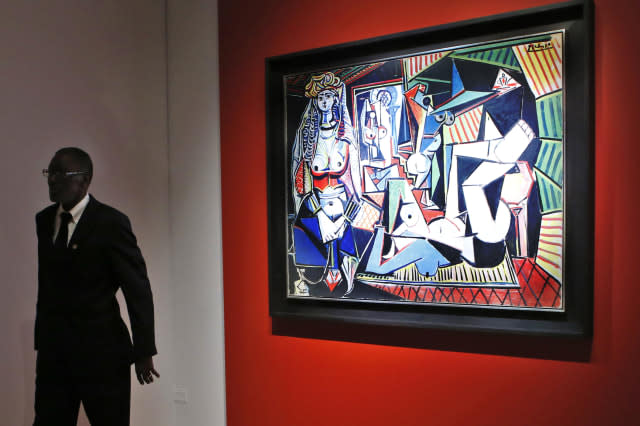Picasso masterpiece sets new world record: $179.4 million


Picasso's Women of Algiers has set a new world record for the most expensive painting ever sold at auction - after selling for $102.6 million (or $179.3 million including commission). That's the equivalent of £115 million; but is it money well spent?
The sale, by Christie's in New York last night, knocks Francis Bacon's Three Studies of Lucian Freud into second place. It sold in 2013 for $142.4 million - which was dwarfed by the latest sale.
The Picasso painting has risen incredibly in value over recent years. Christie's sold it in 1997, and while it had an estimate of between $10 and $12 million at the time, it sold for $31.9 million.
The BBC spoke to one art investment expert who said that the new price may mean other Picasso paintings are worth even more. He added: "$179 million in 10 years' time will probably look inexpensive." The Guardian spoke to another who pointed out that each time a work by an artist fetches a higher price, it further enhances their reputation, and makes future rises even more likely.
At the same auction a sculpture by Alberto Giacometti sold for $141.3 million. Pointing Man is now the most expensive sculpture ever sold.
%VIRTUAL-ArticleSidebar-investing-stories%
Warning
This kind of phenomenal growth is enough to turn the heads of investors, especially those who already have plenty of money in cash and shares, and want to spread their investment over a number of different assets. However, before you dip a toe into the art investment world, it's essential to understand the downside risk.
Patrick Connolly, Certified Financial Planner, Chase de Vere, told AOL that even before you think about the value, you need to consider the costs associated with investing in art. If you choose an art fund there are charges to factor in, and if you invest directly you need to think about auction fees, insurance, storage costs, and specialist advice on what to buy.
There are practical issues to face too - such as the fact that when you want to cash in your investment you will need to find a buyer, and if your timing is unfortunate, then you could struggle, and end up knocking the price down to get rid of it.
Then, there's the question of value. He explains: "Works of art don't produce any earnings or income, so price fluctuations are based solely on supply and demand - and tastes change over time so there can be big prices movements if particular artists or their works come in or out of favour." This may be less of a concern if you are buying a Picasso masterpiece, but few investors can afford artworks of this class, so end up investing in something where prices have been less secure.
Connolly adds: "These investments are unregulated, which means that investors cannot fall back on the Financial Services Compensation Scheme or any other body if their investment goes wrong." It means, he says, you are investing in something unregulated, illiquid, with high charges, produces no income and with potentially volatile performance. He adds: "This isn't exactly appealing to most investors."
He concludes that there's no problem with buying art that you like and can afford, purely for the pleasure of it, but as an investment, he says: "The downside risks of these assets significantly outweigh any potential benefits and so we don't recommend alternative investments such as art or any other 'collectables' to our clients."
Auctions on AOL Money
First issue of Playboy - featuring Marilyn Monroe - set to sell for $2,700
Tiny painting 'worth £300' sells for £120,000
Perfect 100 carat diamond sold for $22.1 million



